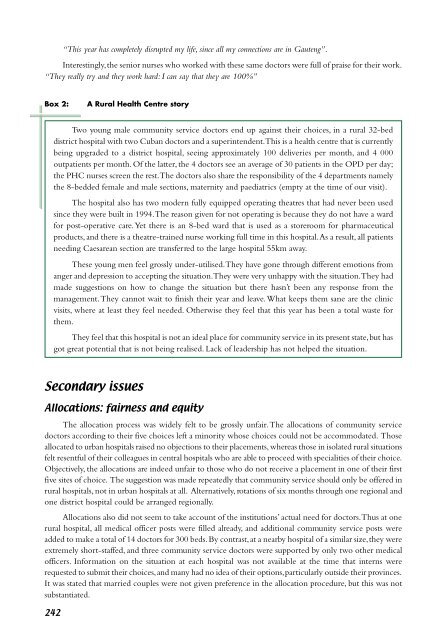Monitoring the implementation of community service
Monitoring the implementation of community service
Monitoring the implementation of community service
You also want an ePaper? Increase the reach of your titles
YUMPU automatically turns print PDFs into web optimized ePapers that Google loves.
242<br />
“This year has completely disrupted my life, since all my connections are in Gauteng”.<br />
Interestingly, <strong>the</strong> senior nurses who worked with <strong>the</strong>se same doctors were full <strong>of</strong> praise for <strong>the</strong>ir work.<br />
“They really try and <strong>the</strong>y work hard: I can say that <strong>the</strong>y are 100%”<br />
Box 2: A Rural Health Centre story<br />
Two young male <strong>community</strong> <strong>service</strong> doctors end up against <strong>the</strong>ir choices, in a rural 32-bed<br />
district hospital with two Cuban doctors and a superintendent. This is a health centre that is currently<br />
being upgraded to a district hospital, seeing approximately 100 deliveries per month, and 4 000<br />
outpatients per month. Of <strong>the</strong> latter, <strong>the</strong> 4 doctors see an average <strong>of</strong> 30 patients in <strong>the</strong> OPD per day;<br />
<strong>the</strong> PHC nurses screen <strong>the</strong> rest. The doctors also share <strong>the</strong> responsibility <strong>of</strong> <strong>the</strong> 4 departments namely<br />
<strong>the</strong> 8-bedded female and male sections, maternity and paediatrics (empty at <strong>the</strong> time <strong>of</strong> our visit).<br />
The hospital also has two modern fully equipped operating <strong>the</strong>atres that had never been used<br />
since <strong>the</strong>y were built in 1994. The reason given for not operating is because <strong>the</strong>y do not have a ward<br />
for post-operative care. Yet <strong>the</strong>re is an 8-bed ward that is used as a storeroom for pharmaceutical<br />
products, and <strong>the</strong>re is a <strong>the</strong>atre-trained nurse working full time in this hospital. As a result, all patients<br />
needing Caesarean section are transferred to <strong>the</strong> large hospital 55km away.<br />
These young men feel grossly under-utilised. They have gone through different emotions from<br />
anger and depression to accepting <strong>the</strong> situation. They were very unhappy with <strong>the</strong> situation. They had<br />
made suggestions on how to change <strong>the</strong> situation but <strong>the</strong>re hasn’t been any response from <strong>the</strong><br />
management. They cannot wait to finish <strong>the</strong>ir year and leave. What keeps <strong>the</strong>m sane are <strong>the</strong> clinic<br />
visits, where at least <strong>the</strong>y feel needed. O<strong>the</strong>rwise <strong>the</strong>y feel that this year has been a total waste for<br />
<strong>the</strong>m.<br />
They feel that this hospital is not an ideal place for <strong>community</strong> <strong>service</strong> in its present state, but has<br />
got great potential that is not being realised. Lack <strong>of</strong> leadership has not helped <strong>the</strong> situation.<br />
Secondary issues<br />
Allocations: fairness and equity<br />
The allocation process was widely felt to be grossly unfair. The allocations <strong>of</strong> <strong>community</strong> <strong>service</strong><br />
doctors according to <strong>the</strong>ir five choices left a minority whose choices could not be accommodated. Those<br />
allocated to urban hospitals raised no objections to <strong>the</strong>ir placements, whereas those in isolated rural situations<br />
felt resentful <strong>of</strong> <strong>the</strong>ir colleagues in central hospitals who are able to proceed with specialities <strong>of</strong> <strong>the</strong>ir choice.<br />
Objectively, <strong>the</strong> allocations are indeed unfair to those who do not receive a placement in one <strong>of</strong> <strong>the</strong>ir first<br />
five sites <strong>of</strong> choice. The suggestion was made repeatedly that <strong>community</strong> <strong>service</strong> should only be <strong>of</strong>fered in<br />
rural hospitals, not in urban hospitals at all. Alternatively, rotations <strong>of</strong> six months through one regional and<br />
one district hospital could be arranged regionally.<br />
Allocations also did not seem to take account <strong>of</strong> <strong>the</strong> institutions’ actual need for doctors. Thus at one<br />
rural hospital, all medical <strong>of</strong>ficer posts were filled already, and additional <strong>community</strong> <strong>service</strong> posts were<br />
added to make a total <strong>of</strong> 14 doctors for 300 beds. By contrast, at a nearby hospital <strong>of</strong> a similar size, <strong>the</strong>y were<br />
extremely short-staffed, and three <strong>community</strong> <strong>service</strong> doctors were supported by only two o<strong>the</strong>r medical<br />
<strong>of</strong>ficers. Information on <strong>the</strong> situation at each hospital was not available at <strong>the</strong> time that interns were<br />
requested to submit <strong>the</strong>ir choices, and many had no idea <strong>of</strong> <strong>the</strong>ir options, particularly outside <strong>the</strong>ir provinces.<br />
It was stated that married couples were not given preference in <strong>the</strong> allocation procedure, but this was not<br />
substantiated.

















